A superb bird’s-eye-view of Venice, finely-engraved and exceptionally adorned.
Venetia
Out of stock
Description
Here we have an excellent example of Giovanni de Paoli’s rare and exciting bird’s-eye-view of Venice, dating to the dawn of the long 17th century. The view shows Venice from an oblique angle, including the Giudecca islands fronting the city proper and the San Michele cluster behind it (north). As in reality, the city itself has been subdivided into neighborhoods, the oldest and most central one of which is San Marco. Important buildings and landmarks are identified throughout the city by a label or a number that refers to the key in the map’s bottom panel.
The print is a magnificent copper-plate etching on a sheet measuring 20 x 14 inches. It was printed on contemporary laid paper, with full margins, and in near perfect condition and is signed in the lower-left corner. De Paoli’s version of this view was edited and published in Rome but drew on a specific model for depicting the lagoon city that originally had been proposed by Giacomo Franco and Bernardo Salvioni at the end of the sixteenth century.
In addition to following a general template and replicating many details, a critical element of the composition is a large vignette inserted below the view of the city. This scene depicts a most infamous spectacle: the procession of the Doge of Venice, and was adapted directly from the Franco-Salvioni view published just a few years earlier. Following the Doge and his entourage are pilgrims returned from Jerusalem, and in the panel below, the procession continues with first the damsels (donzelle), then the princesses (principella), then the matrons (matrone), and finally the gentlewomen (gentildonne; unmarried women of the nobility) of the Venetian court.
Smaller vistas of major Venetian landmarks have been inserted on both flanks of the procession. The well-known Piazza San Marco is to the left, and on the right, we see the equally famous Ponte Rialto. Separating the central image of the procession with the two flanking images of Venetian landmarks, we find a key listing 92 individual numbered buildings, which the mapmaker depicts on the plan itself. The identified landmarks include all of Venice’s most famous churches and other significant institutions.
Context is everything
De Paoli often reprinted works by other publishers, acquiring the plates after their deaths; this is also the case here. Our exquisite view bears many similarities to earlier works, particularly to a striking plan created by Matteo Florimi in 1598 (although there are several subtle variations in de Paoli’s version) and other contemporary Italian urban vistas – especially those of Giacomo Franco and Bernardo Salvioni.
De Paoli’s goal was most likely to create a Roman version of the well-established Salvioni plan, but in this case, intended for the local market and designed as direct competition to both Venetian and Tuscan counterparts. The original Roman publisher of de Paoli’s plan remains unknown, making any absolute dating near impossible. Most scholars nevertheless agree that this plan was issued around 1600 to align smoothly with the output of Venetian and Tuscan engravers.
Cartographer(s):
Giovanni Antonio de Paoli was an editor and printer active in Rome between 1589 and 1630, where he had a print shop in Santa Maria della Pace. Historical sources show that he petitioned and obtained publishing privileges from the Pope in 1599, 1605, and 1624. In his initial 1599 petition, de Paoli states unequivocally that he aims to ‘publish religious, rare and exemplary images, including portraits’. He would often purchase plates of other engravers after their deaths and reuse them in his own name. We know that he did this with the plates of Altiero Gatti, which were reprinted after Jatti’s death in 1596, but now with de Paoli’s name included as the owner.
Condition Description
Minor wear along the margins.
References
Schultz 56; Cassini p. 63; G. Moretto (a cura di) "Venetia - Le immagini della Repubblica", s. 57.



